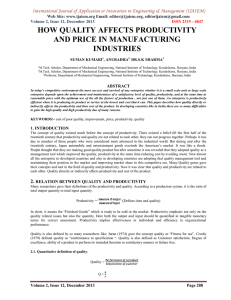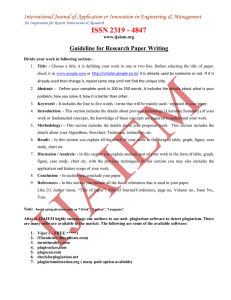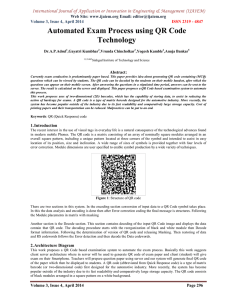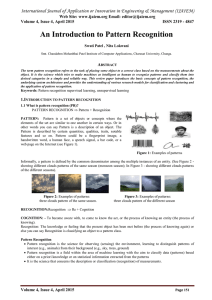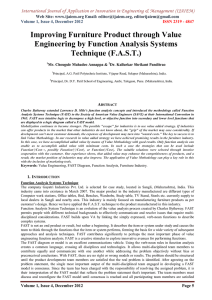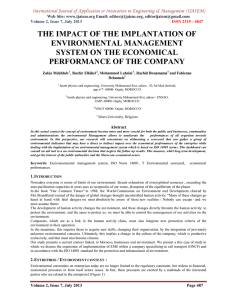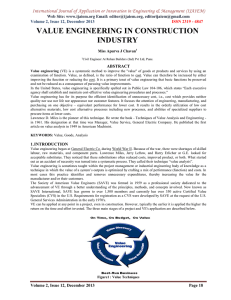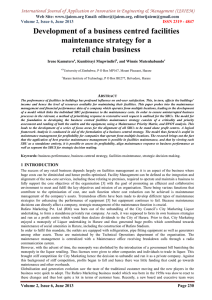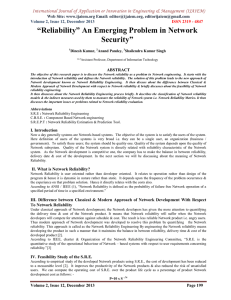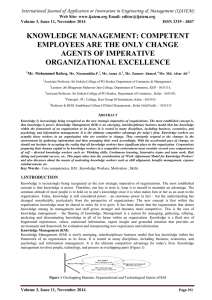Marketing Management: Corporate Strategic Management & Planning – An Introduction
advertisement
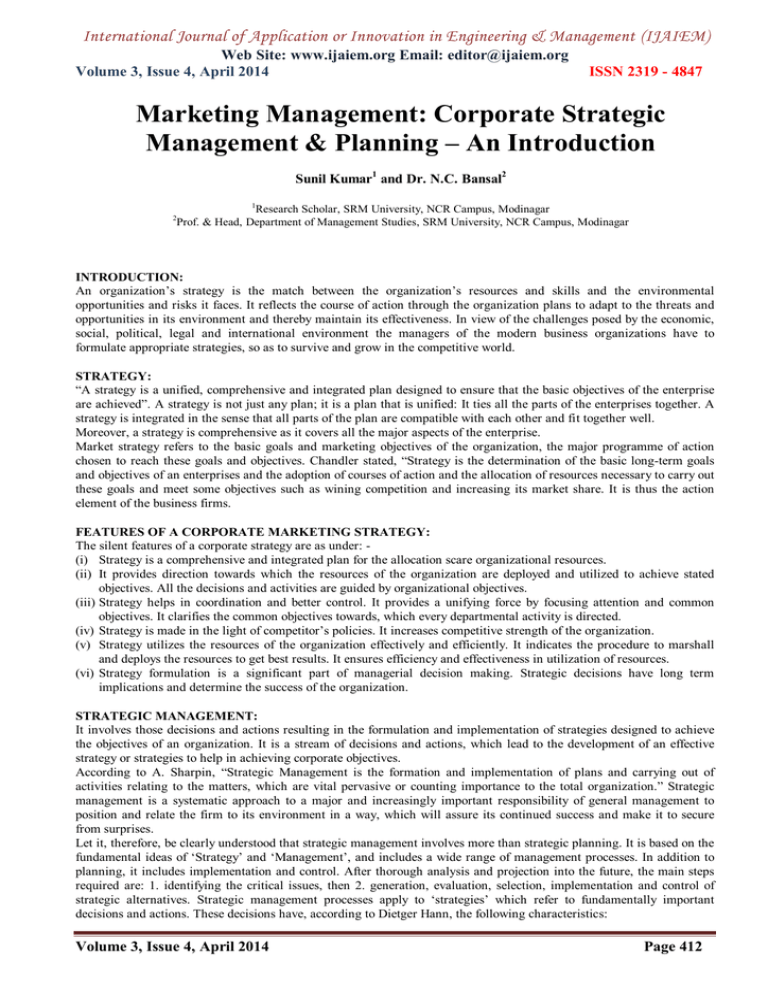
International Journal of Application or Innovation in Engineering & Management (IJAIEM) Web Site: www.ijaiem.org Email: editor@ijaiem.org Volume 3, Issue 4, April 2014 ISSN 2319 - 4847 Marketing Management: Corporate Strategic Management & Planning – An Introduction Sunil Kumar1 and Dr. N.C. Bansal2 1 Research Scholar, SRM University, NCR Campus, Modinagar Prof. & Head, Department of Management Studies, SRM University, NCR Campus, Modinagar 2 INTRODUCTION: An organization’s strategy is the match between the organization’s resources and skills and the environmental opportunities and risks it faces. It reflects the course of action through the organization plans to adapt to the threats and opportunities in its environment and thereby maintain its effectiveness. In view of the challenges posed by the economic, social, political, legal and international environment the managers of the modern business organizations have to formulate appropriate strategies, so as to survive and grow in the competitive world. STRATEGY: “A strategy is a unified, comprehensive and integrated plan designed to ensure that the basic objectives of the enterprise are achieved”. A strategy is not just any plan; it is a plan that is unified: It ties all the parts of the enterprises together. A strategy is integrated in the sense that all parts of the plan are compatible with each other and fit together well. Moreover, a strategy is comprehensive as it covers all the major aspects of the enterprise. Market strategy refers to the basic goals and marketing objectives of the organization, the major programme of action chosen to reach these goals and objectives. Chandler stated, “Strategy is the determination of the basic long-term goals and objectives of an enterprises and the adoption of courses of action and the allocation of resources necessary to carry out these goals and meet some objectives such as wining competition and increasing its market share. It is thus the action element of the business firms. FEATURES OF A CORPORATE MARKETING STRATEGY: The silent features of a corporate strategy are as under: (i) Strategy is a comprehensive and integrated plan for the allocation scare organizational resources. (ii) It provides direction towards which the resources of the organization are deployed and utilized to achieve stated objectives. All the decisions and activities are guided by organizational objectives. (iii) Strategy helps in coordination and better control. It provides a unifying force by focusing attention and common objectives. It clarifies the common objectives towards, which every departmental activity is directed. (iv) Strategy is made in the light of competitor’s policies. It increases competitive strength of the organization. (v) Strategy utilizes the resources of the organization effectively and efficiently. It indicates the procedure to marshall and deploys the resources to get best results. It ensures efficiency and effectiveness in utilization of resources. (vi) Strategy formulation is a significant part of managerial decision making. Strategic decisions have long term implications and determine the success of the organization. STRATEGIC MANAGEMENT: It involves those decisions and actions resulting in the formulation and implementation of strategies designed to achieve the objectives of an organization. It is a stream of decisions and actions, which lead to the development of an effective strategy or strategies to help in achieving corporate objectives. According to A. Sharpin, “Strategic Management is the formation and implementation of plans and carrying out of activities relating to the matters, which are vital pervasive or counting importance to the total organization.” Strategic management is a systematic approach to a major and increasingly important responsibility of general management to position and relate the firm to its environment in a way, which will assure its continued success and make it to secure from surprises. Let it, therefore, be clearly understood that strategic management involves more than strategic planning. It is based on the fundamental ideas of ‘Strategy’ and ‘Management’, and includes a wide range of management processes. In addition to planning, it includes implementation and control. After thorough analysis and projection into the future, the main steps required are: 1. identifying the critical issues, then 2. generation, evaluation, selection, implementation and control of strategic alternatives. Strategic management processes apply to ‘strategies’ which refer to fundamentally important decisions and actions. These decisions have, according to Dietger Hann, the following characteristics: Volume 3, Issue 4, April 2014 Page 412 International Journal of Application or Innovation in Engineering & Management (IJAIEM) Web Site: www.ijaiem.org Email: editor@ijaiem.org Volume 3, Issue 4, April 2014 ISSN 2319 - 4847 They substantially affect a company’s ability to generate cash profits; They relate to company as a whole; They are taken by the top executives team and the Board of Directors; They take effect in the long-term and therefore, tend to be made infrequently; and They reflect the values of top management and are taken in accordance with corporate philosophy and culture. Thus, strategic management involves the development and communication of the corporate goals, the strategic plans, the corporate philosophy and the corporate culture. Based on this analysis, Hahn defines the tasks and responsibilities of strategic management as follows: 1. Determining the corporate philosophy; 2. Defining the corporate objectives and goals; 3. Formulating business strategies, functional strategies and regional strategies; 4. Planning the organization structure and its legal forms ; 5. Planning the management systems and process including; Management development Information systems and Management pay and incentives; 6. The process of implementation and supervision and 7. The design of the desired corporate culture. 6 STRATEGIC PLANNING: According to Glueok and Synder, “ Strategic planning is a set of interactive and over lapping decisions, leading to the words of Robert Anthony”, Strategic Planning is the process of deciding on the objectives of the organization, on changes in these objectives, on the resource used to attain these objectives and on the policies that will govern the acquisition, use and disposition of the resources.” According to Hax and Majluf, corporate planning is neither a top-down nor a bottom-up process. It is a much more complex activity, which requires a strong participation of key managers of the firm where objectives are being proposed from the top and the specific pragmatic alternatives are being suggested from business and functional levels. However, in this approach there is risk of excessive bureaucratization and internationalization of sub-unit goals inducing centrifugal tendencies to develop. According to James Brian Quinn, the actual planning process is usually fragmented, evolutionary and largely intuitive. There is need for a compromise between formal planning us, opportunistic planning to provide for unexpected occurrences and perhaps, for program-period planning process instead of calendar-driven systems so that program initiatives are generated at any time during the year. ROLE OF STRATEGY AND PLANNING: Strategy formulation has become an important function of modern marketing management, because of the following reasons: i. Every business should have a strategy or an overall plan of action to meet the challenges of environment in future. An effective strategy would enhance the likelihood of business survival and enable to meet aspirations of individuals for opportunities in the company. ii. Strategic planning clarifies the objective of the organization towards which its resources will be directed. All decisions and activities are guided by organizational objectives. iii. Strategic planning facilitates the implementation of long range plans for achieving organizational goals. It is also important in defining the kind of business in which the organization engages and its reliance on ethical business practices. iv. The companies that do strategic planning are able to predict the outcome of planning better than other companies. v. Strategic Planning facilitates environmental scanning. It helps in reducing environmental uncertainty by identifying key factors for the success of the business strategic planning is the only way to anticipate future problems and opportunities and to respond to changing environment. COMPANY’S MARKETING ENVIRONMENT: A company does exist in the larger socio-economic environment. It obtains resources form the environment and converts them into useful products and services. In the process, it has to interact with customers, suppliers, intermediaries’ government agencies and other stake holders of the business. Al these agents and institutions constitute a company’s marketing environment. They act as facilitation as well as impediments on the marketing efforts of a company. Therefore, as a subsystem in the larger socio-economic environment, a firm must be open and adoptive because the environment is changing fast. The components of company’s marketing environment can be classified into three categories. They are company’s own internal environment, company’s proximate macro environment and uncontrollable macro environment forces. The Volume 3, Issue 4, April 2014 Page 413 International Journal of Application or Innovation in Engineering & Management (IJAIEM) Web Site: www.ijaiem.org Email: editor@ijaiem.org Volume 3, Issue 4, April 2014 ISSN 2319 - 4847 marketing firm has absolute control over its internal environment and it can be maintain internal relationship for best marketing results. It may have partial control over its proximate macro environment suppliers, intermediaries, competitors and publics whereas marketing firm cannot control and macro environment forces – demography, socio-cultural forces, economic forces, technology, political and legal forces and ecology. ROLE OF MARKETING STRATEGIES FOR COPORATE GROWTH: The global environment is changing rapidly because of multifaceted changes taking place around the world. The political environment together with economical, technical, social and legal environment, are also undergoing rapid metamorphosis. The impact of such changes has led to worldwide competition for business. These environmental factors and forces are to be studied and evaluated by business enterprises before formulation of their business policy, future plans and programs. Strategic management is the important area of modern management relating to long-term corporate planning of business. It deals with company’s mission and objective in the changing perspective environment. CONCEPT OF STRATEGY: Strategy can be defined as interpretative planning strategy includes the determination and evaluation of alternative paths to already established mission or objective and eventually choosing the right alternative. A strategy outlines; management decides and plans to achieve its goals and objectives. Management formulates strategy to shade out the effect of other policies of its own unit for the purpose of out the overall plan and programs for Competitors’ policy to avail of competitive advantages, Strategic management is a stream of decisions and actions with a view to develop effective long-term planning and policies with technological business forecasting, which would help the enterprise to achieve its super ordinate goal. Strategic management includes strategic analysis, strategic choice; strategic implementation and control. Strategic decisions for an enterprise might be to deploy resources into new opportunities in the enterprises such strategic decisions may result in the need of following strategies as: (i) New Product Development (ii) Product re-designing (iii) Up-gradation of Product (iv) Strategic Marketing (v) Strategic for Technology (vi) New Customers (vii) Urgency of Finance (viii) Market Segmentation (ix) Entry into new Market LEVEL OF MARKETING STRATEGY: These strategies may be classified as below: (a) Corporate Level Strategy: It is a long-term comprehensive plan for an enterprise. This strategy is formulated by top level management to decide the actions that a total unit is taking and attempts to determine the role of its business activity is playing and should play in an organization. It defines long-term objectives for future business plan about the product, market, profitability, returns on investment, technological leadership, competitive positions etc. (b) Business Level Strategy: This strategy should be framed in line with the corporate level strategy. The comprehensive general plan, programs, budget, schedule and policies through, which a business organization intends to achieve its long-term objective i.e. corporate level strategy in an ever changing environment, is called unit level strategy. (c) Functional Level Strategy: This type of strategy creates framework for management functions, such as finance, research and development, production, materials, human resources and marketing, so they confirm to the business level strategy. CONCLUSION Strategic management is an all-encompassing term which has very recently come into vague. It has organization-wide ramifications for achievement of organizational goals through effective use of its limited resources. Its scope extends beyond strategic planning including SWOT analysis to implementation which sometimes may entail even resources, structural and leadership changes. Control and evaluation are its essential ingredients. The strategic management in such a purest form is rarely practiced. They are very wide inter and intra-country differences. Volume 3, Issue 4, April 2014 Page 414 International Journal of Application or Innovation in Engineering & Management (IJAIEM) Web Site: www.ijaiem.org Email: editor@ijaiem.org Volume 3, Issue 4, April 2014 ISSN 2319 - 4847 In India, strategic management is at a nascent stage. There is a growing consciousness among Indian managers of its utility from all organizational angles but as elsewhere, they regard it as a complex and time-consuming activity. Many executives disregard strategic planning by suggesting that it is a fruitless exercise as in a dynamic environment, the accurate prediction of future is a remote possibility. However, the Indian executives have, by and large overcome this mental barrier. They believe strategic planning prepares a firm to met future risks, systematically deal with uncertainty and above all, being a mind-stretching creative exercise, helps in improving quality of management thinking. The strategic management practices enable a firm to choose its strategy and implement it. Therefore, an ultimate outcome of strategy implementation has a bearing of strategic choice which is exercised after a careful consideration of all circumstances. Thus, the performance of a firm is the function of strategy predominantly pursued by a firm. In order to relate economic performance with strategic choice of a firm, the profitability ratios (PBT/Sales) are the indicators of its impact. As organizational complexity and environmental uncertainty are growing, the strategic decision-making has to be more and more a group effort-an-effort which is not mere ‘rubber stamping’ of the CEOs decision or represents whims and fancies of a powerful interest group, rather one which seeks active involvement of all concerned. This group will have to generate knowledge of developing a new class of information systems called strategic knowledge systems consists of a network of trusted managers, business associates and management information systems that provide sensitive information needed for strategic decision-making and also serve as a forum for discursively resolving assumption differences among strategy makers. A Queer paradox is that those who are interested in the benefits and results of planning are often not those that entrusted with its execution. In the absence of involvement culture, the operations corporate philosophy governs behavior of people but many companies do not have such philosophy as well, in such a situation, they are simply mudding through and unclear definitions of business falling, in turn, to identify opportunities they are particularly suited to seize. NOTES AND REFERENCES 1. The classification of stages of evolution into five and discussion thereon is based on Arnoldo C. Hax and Nicolas S. Majtuf, Strategic Management. An integrative Perspective. Prentice-Hall International, Inc., Englewood Cities, NJ, USA, 1984. 2. Robert McGlashan and Timothy Singleton, Strategic Mangement, Merrill Publishing Company, Columbus, Ohio, 1987, pp. 1-26. 3. F.W. Glueck , S.P. Kaufman and A.S. Walleck, “Strategic Management for Competetive Advantage”, Harvard Business Review, 58(4), Jul/Aug. 1980, pp 159-61. 4. 15. H.I. Ansoff, R.P. DeClerck and R.L. Hayes, “From Strategic Planning to Strategic Management”, in H.I. Ansoff et al. (Eds.), from Strategic Planning to Strategic Management , pp, 39-78, Wiley, New York, 1976. 5. Yvan Allatre and Mthaela E. Firstrotu, op. cit., p.8. 6. Dietger Hahn, “Strategic Management-Tasks and Challenges in the 1990s”, Long Range Planning, Vol. 24, No. 1, Feb.1991, P.27. 7. Ibid., p.28. 8. P.K. Ghosh, "Strategic Planning and Management", Sultan Chand & Sons, New Delhi, 2001. 9. Journals: Marketing in Indian Economy – Management Accountant News Papers: 10. Economic times (Daily) New Delhi 11. The Times of India (Daily), New Delhi 12. Business Standard (Daily), New Delhi Magazines: 13. Business World 14. Business India 15. Websites: www.economictimes.com Volume 3, Issue 4, April 2014 Page 415
